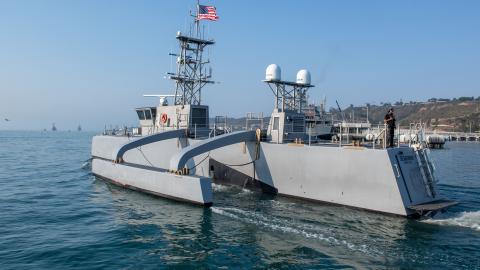Taiwan’s democratic system, technological prowess, and strategic location have made it an essential actor in geopolitics. The island produces nearly 90 percent of the world’s highly advanced semiconductors, and its proximity to key shipping lanes in the Indo-Pacific makes it a critical node in global trade. Unfortunately, Taiwan’s importance also renders it vulnerable.
China’s aggressive approach to Taiwan incorporates gray-zone tactics, military signaling, disinformation, and economic coercion. But Taiwan is increasingly under assault in cyberspace as well. In 2024, the island faced an average of 2.4 million cyberattacks per day. These ranged from probes of government systems to intrusions into energy infrastructure and logistics networks. Although few of these attacks made global headlines, they represent a steady campaign of digital attrition. Should Beijing escalate toward conflict, these systems will likely be China’s first targets. Disabling would both weaken Taiwan’s defense capabilities and paralyze its society without expending a single missile.
The threat of cyber warfare is already shaping how modern conflicts unfold. The Russian invasion of Ukraine in 2022 began with a barrage of cyberattacks designed to degrade Ukraine’s command and control infrastructure and isolate Kyiv from international support. These attacks, which accompanied kinetic operations, offered a playbook for future cyber-enhanced engagements that Beijing is studying closely.
The Vulnerabilities Within
Taiwan’s digital infrastructure is advanced yet fragile. The island imports over 90 percent of the fossil fuels it consumes, and more than half its electricity comes from coal and liquefied natural gas. Taiwan’s power generation depends on highly centralized and digitized industrial control systems, such as supervisory control and data acquisition (SCADA) and distributed control system (DCS) networks, which are vulnerable to sabotage. Cyberattacks on Taiwan’s energy grid, especially in conjunction with kinetic strikes on facilities, could cause blackouts in major cities and cripple emergency services.
Telecommunications are also at risk. Only 15 undersea data cables connect Taiwan to the rest of the world. Several of these cables have already been damaged, some under suspicious circumstances. Taiwan has partnered with European and American firms for satellite connectivity, but the island’s current capabilities provide only a fraction of the necessary bandwidth for wartime resilience.
Every layer of Taiwanese society depends on secure digital infrastructure: medical infrastructure, financial services, semiconductor manufacturing, and even air and maritime logistics. Disabling these systems would not only sow chaos within Taiwan. It would also send shockwaves across global markets, particularly in the technology sector. Semiconductor supply chains are uniquely concentrated and difficult to replicate. A disruption in Taiwan would ripple through the markets for nearly every product from smartphones to fighter jets.
The Disinformation Dimension
Beyond infrastructure, Taiwan is subject to sustained influence operations. China’s cyber units deploy thousands of operatives to flood social media with propaganda, stoke division, and undermine public trust in Taiwan’s democratic institutions. These digital campaigns often accompany military exercises or diplomatic pressure, creating a layered effect that tests the resilience of Taiwan’s political system without triggering international retaliation.
Unlike conventional military strategies that emphasize overwhelming force, China’s cyber approach seeks to degrade Taiwan’s functionality as a state and a society. The goal is to digitally isolate the island, fracture social trust among Taiwanese people, and paralyze Taiwan’s economy. The longer this campaign persists without an international response, the more emboldened Beijing becomes.
Lessons from Other Fronts
Taiwan’s experience is not unique. From Kyiv to Tel Aviv, governments are learning that modern warfare begins in the digital domain. In Ukraine, the migration of critical systems to the cloud helped preserve continuity of government services despite physical destruction. Israel’s cyber capabilities enabled it to respond rapidly to Iranian attacks and take part in joint operations with the United States. Both cases underscore the value of pre-crisis planning, hardened infrastructure, and integrated cyber alliances.
In the Indo-Pacific, however, such integration is lacking. While the United States maintains robust bilateral relationships with Japan, South Korea, and Australia, there is no institutional framework for joint cyber defense or coordinated retaliation in response to an attack on Taiwan. This ambiguity undermines deterrence. If Taiwan’s grid is taken offline or its financial networks are sabotaged, would Tokyo respond? Would Washington activate countermeasures inside Chinese networks? The absence of a clear doctrine that Taiwan’s allies and partners can implement immediately following a Chinese cyberattack guarantees hesitation. This knowledge gives China a critical advantage.
Building a Resilient Defense
Taiwan has taken steps to address these risks. In 2025, it raised its defense budget to 3 percent of GDP. But relatively little of this funding has gone toward digital resilience. That needs to change. A modern defense strategy should allocate at least $300 million annually to cyber readiness and infrastructure hardening. Key priorities include:
- Migrating core government and industrial systems to secure, redundant cloud environments
- Developing offline recovery capabilities for financial, energy, and defense institutions
- Establishing robust coordination between the public and private sectors for incident response
- Conducting joint cyber exercises with allies to simulate hybrid conflict scenarios
- Creating secure channels for real-time threat intelligence sharing and escalation planning
- Investing in advanced endpoint protections, firmware-level security, and artificial intelligence–enabled threat detection
Cyber resilience is the foundation upon which all other forms of deterrence depend. A country cannot fight if it cannot communicate. It cannot govern if its systems are paralyzed. For Taiwan, staying online is essential to staying sovereign.
The Global Dimension
The security of Taiwan’s digital infrastructure has global implications. For Beijing, taking control of Taiwan is about more than territory. It is about asserting dominance over the Indo-Pacific and reshaping the global order on its terms. For Washington and its allies, helping Taiwan defend its networks is necessary to preserve the integrity of democratic institutions, secure global supply chains, and deter future aggression elsewhere.
The United States has already seen the implications at home. Chinese state-backed groups, such as Volt Typhoon, have infiltrated American critical infrastructure in recent years. The tactics used against Taiwan today may well be deployed against San Diego, Norfolk, or Houston tomorrow. Defending Taiwan’s networks, therefore, is an investment in shared security.
Resilience is Deterrence
Cyber conflict will certainly accompany a Taiwan crisis. The question is whether Taiwan will be prepared to endure it. Policymakers should act now to strengthen digital resilience to convince China that a quick victory is impossible.
The survival of Taiwan’s democracy and economy depends on its ability to resist a digital siege. That is a lesson not just for Taipei, but for Washington, Tokyo, and beyond. In this new era of competition, resilience is deterrence.




















